-
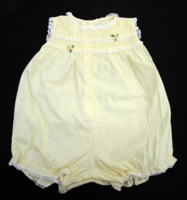
Infants yellow cotton romper with lace, smocking, and ribbon trim
-
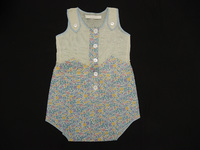
Floral print childrens romper with button straps
-

Floral print dress with smocking
-
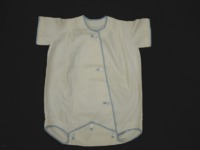
Off-white envelope romper with blue bias trim
-
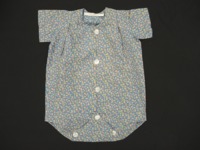
Child's envelope romper with blue floral print.
-
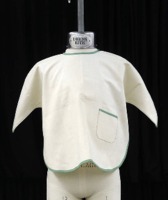
Off-white big with green trim.
-
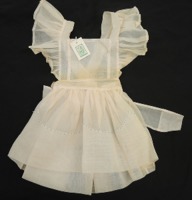
Pink sheer pinafore with shoulder ruffles and french knot embroidery. Tagged with New Hampshire League of Arts and Crafts.
-
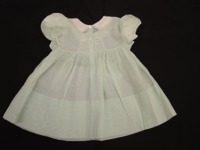
Light green sheer handmade child's dress with peter pan collar, faggoting, and floral embroidery
-
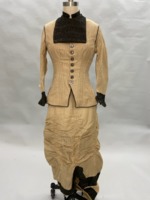
female; dress; 1880s; bodice-mandarin collar, piped armscye, shaped sleeves, shirred olive silk cuff and square bib, princess lines, 11 abalone button center front; skirt-underskirt of olive pleated silk, cream open weave, shirred, side seam pleats
-
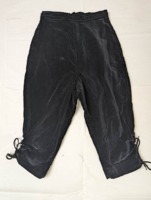
Original Sandora Regent tag. Cotton velvet knee length trousers with ties
-
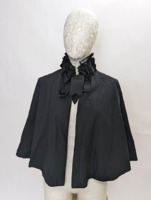
Victorian Silk Cape
-
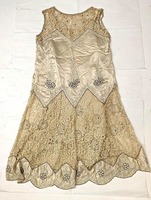
1920s beaded dress
-
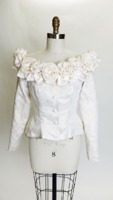
Brocade wedding jacket with fabric roses. Designed by Evelyn Bash. Evelyn Bash was a bridal designer with a shop in Clinton, MA from 1993-2013.
-
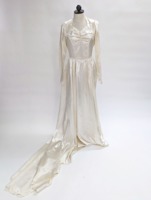
Janina + Nancy Swiacki Collection
-

Janina + Nancy Swiacki Collection
-
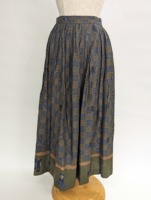
Janina + Nancy Swiacki Collection
-
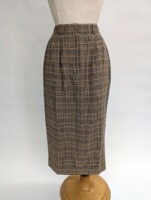
Nancy + Janina Swiacki Collection
-
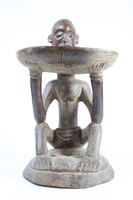
A caryatid stool features a head emerging from the top of the seat, with its lower half showing a more faded patina than the upper part. The seat is decorated with embedded coins. The Tabwa caryatid figure is unique and part of the royal regalia, serving as a vessel for the high-ranking ruler's spirit.
-
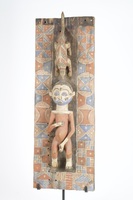
A polychrome wall panel displays a stylized sculpture figure and a chameleon in the center, flanked by decorative red and blue geometric patterns. The panel's stylized, high-relief designs serve as a visual language found in stories or proverbs related to the initiation process. Such panels may be used to teach moral and social values to young adolescents who are about to be initiated.
-
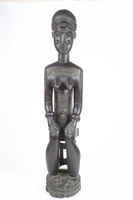
A seated female figure is overall covered with a darkened patina. The Baule people believe that every man or woman has a "spouse" in the spirit world—an individual with a name revealed through divination. Geometric scarification on her torso, chest, upper arms, and face, accompanied by a smooth, raised hairstyle, is typically shown in images of spirit wives.
-
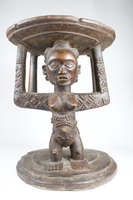
A prestige stool depicts two identical female figures with their arms raised and facing outward. Their prominently stylized breasts and scarification along their extended arms highlight the female body's vital role as a spiritual vessel that embodies divine kinship in Luba society. The artistic refinement of the female form through intricate skin decoration and hairstyle symbolizes the civilization and sophistication that Luba rulers promote within their community. Although it was designed as a stool, it has also been used as a sacred emblem stored in a king's palace.
-
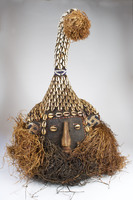
The Kuba Mukyeem mask is is intricately decorated with various materials, such as the glass beads creating facial features and patterns throughout the mask, along with the cowrie shells coating the surface. The protrusion from the forehead resembles an elephant's trunk, establishing a sense of power and stability for the masker. This mask was to be worn during an important ceremony recounting the Kuab creation myth. According to the myth, the first human known as "Shyaam" was the the creator of the Kuba Dynasty and civilization.
-
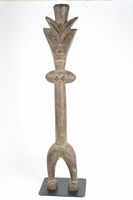
An elongated, figurative statue featuring short, bowed legs and a long torso. Its head is triangular with a deep, angled ornament on top and flat facial features. It is highly stylized and used at the end of ceremonies, following the masquerades. It may represent an ancestor figure.
-
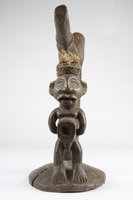
A figurative sculpture depicting a hanged man with arms tied behind his back. Facial features are exaggerated and stylized, with a fiber headdress on top of his head. This sculpture is seen as a cult figure that could be used to warn criminals who might face the fearful penalty for their unethical actions.
-

The Tawba ceremonial chair is highly decorated with triangular patterning surround the base of the chair and back side. The bust at the top of the seat has thinly carved scarification patterns and a stylized coiffure. The neck of the bust blends seamlessly into the seat, connecting the two objects as one. The seat has several marks and scratches, showing the chair was most likely functional as well as decorative.

























